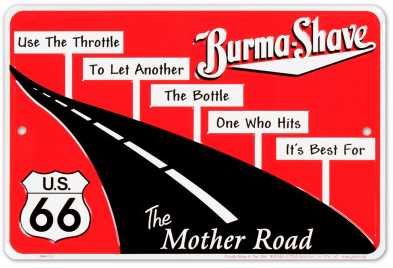Growing up in Boston, there was a series of roadside signs I’d see on the way to the airport. They weren’t flashy or high-tech—just simple white signs with black letters spaced out along the highway that read:
“If You”
“Lived Here”
“You Would”
“Be Home Now”
As a kid, I didn’t think much of them. But looking back, those signs were a brilliant piece of marketing. Short, rhythmic, and impossible to miss, especially in traffic. They weren’t trying to sell a product—they were selling a feeling. A sense of belonging. Of convenience. Of home.
This clever use of sequential roadside signs is actually an advertising tactic with roots going back nearly a century. One of the most iconic examples comes from Burma-Shave, a shaving cream company that became famous for using short rhyming jingles spread across multiple signs to grab the attention of drivers during the early days of car culture. For example:
“Shaving brushes”
“You’ll soon see ’em”
“On a shelf”
“In some museum”
“Burma-Shave”
So why were these signs so effective? For starters, they harnessed motion and anticipation—two elements that naturally engage the human brain. The format forces you to read the entire sequence to get the message, keeping you mentally engaged.
While today’s digital marketing landscape is saturated with noise, these analog tactics still have their place—especially in rural or suburban areas where digital clutter hasn’t quite taken over. Sequential signage works best on secondary roads, where traffic moves slower and drivers have time to notice and digest each message in the series. These aren’t the major interstates dominated by big billboards. They’re local roads—state highways, scenic byways, or even farm roads—where your signs have the potential to stand out.
Because these roads aren’t in high demand by big advertisers, it’s often possible to work directly with just one landowner to gain permission to place your signs. That’s significantly cheaper than going through an outdoor advertising company.
Even better, you don’t need to break the bank to create your own roadside campaign. The same type of corrugated plastic yard signs used for political campaigns are perfect for this purpose. You can order custom yard signs in bulk from online vendors like Vistaprint, Signs On The Cheap, or Uprinting. Stick to high-contrast colors (like black text on white) for easy readability, and keep your messages short. Mount them on wire H-frames or stake them into wooden posts. With a little planning, you can produce a full six-sign campaign for less than the cost of a single traditional billboard rental.
This strategy can be a goldmine for small businesses or local campaigns. Imagine owning an ice cream shop, and as people drive toward town, they read:
“Hot Day?”
“Craving Cold?”
“Turn Ahead”
“For A Treat”
“At Joe’s Creamery”
That’s marketing that doesn’t just inform—it engages and entertains.
You can also get creative with QR codes on the final sign at a stop sign or light. Or include a memorable brand phrase to build recognition. Just make sure your message is:
- Short and punchy
- Easy to read at a distance
- Spaced out with enough time between signs for comprehension
As digital marketing becomes more complicated and privacy restrictions grow tighter, simple analog advertising methods like this can cut through the noise and leave a lasting impression.
So, how can you harness this power?
Start by thinking about your ideal customer’s commute or daily route. Where do they drive that isn’t saturated with ads? Then, brainstorm a short, emotional narrative that unfolds in five to six parts. Finally, seek out a cooperative landowner, get your signs printed, and bring your message to the roadside.
Sometimes, old-school marketing still works best—especially when it’s unexpected.
What emotional journey could you take your customers on with a series of roadside signs?












